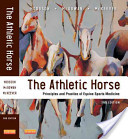The Athletic Horse, Principles and Practice of Equine Sports Medicine, 2nd Edition

Kolektiv autorů v této publikace ukazuje, jak maximalizovat výkon u sportovních koní. V knize jsou popsány sportovní tréninkové režimy a jak eliminovat poranění pohybového aparátu. Úvodní kapitoly jsou zaměřeny na zákklady anatomie a fyziologie koní. Další kapitoly se zabývají vyhodnocením laboratorních výsledků a diagnostických zobrazení u koní s doporučením pro sportovní přípravu nejen v parkuru, ale i závodním využití. Knihy je bohatě barevné ilustrována se zobrazením nejnovějších rehabilitačních technik, zobrazovacích metod. Velice přínosná je kapitola věnována transportu koní s ohledem na jejich pohodu a další sportovní využití.
Autor: David R. Hodgson, BVSc, PhD, FACSM, Catherine McGowan, BVSc, MACVSc, DEIM, DECEIM, PhD, FHEA, MRCVS and Kenneth McKeever, PhD, FACSM
| Nakladatel | Elsevier Saunders |
|---|---|
| ISBN | 9780721600758 |
| Vydání | 397 |
| Vazba | pevná |
| Počet stran |
Showing how to maximize performance in horses, The Athletic Horse: Principles and Practice of Equine Sports Medicine, 2nd Edition describes sports training regimens and how to reduce musculoskeletal injuries. Practical coverage addresses the anatomical and physiological basis of equine exercise and performance, centering on evaluation, imaging, pharmacology, and training recommendations for sports such as racing and show jumping. Now in full color, this edition includes new rehabilitation techniques, the latest imaging techniques, and the best methods for equine transportation. Written by expert educators Dr. David Hodgson, Dr. Catherine McGowan, and Dr. Kenneth McKeever, with a panel of highly qualified contributing authors.
| Section I: Structure Considerations in Equine Sports Medicine | 1 |
| 1. An Overview of Performance and Sports Medicine | 1 |
| 2. Comparative Aspects of Exercise Physiology | 9 |
| Section II: Physiology of Exercise and Performance | 19 |
| 3. Energetic Considerations of Exercise | 19 |
| 4. Nutrition of the Performance Horse | 34 |
| 5. Hematology and Biochemistry | 56 |
| 6. Physiology of Acid-Base Balance and Fluid Shifts with Exercise | 69 |
| 7. Endocrine and Immune Responses to Exercise and Training | 88 |
| 8. Thermoregulation | 108 |
| 9. The Respiratory System: Anatomy, Physiology, and Adaptations to Exercise and Training | 125 |
| 10. Transport of Horses | 155 |
| 11. The Cardiovascular System: Anatomy, Physiology, and Adaptations to Exercise and Training | 162 |
| 12. Muscle: Anatomy, Physiology, and Adaptations to Exercise and Training | 174 |
| 13. Tendon, Ligament, Bone, and Cartilage: Anatomy, Physiology, and Adaptations to Exercise and Training | 202 |
| 14. Age and Disuse in Athletes: Effects of Detraining, Spelling, Injury, and Age | 243 |
| Section III: Biomechanics/Kinematics and Performance | 253 |
| 15. Conformation | 253 |
| 16. The Biomechanics of Equine Locomotion | 266 |
| 17. Kinematics of the Equine Back and Pelvis | 282 |
| 18. Functional Biomechanics: The Effect of the Rider and Track | 293 |
| Section IV: Practical Exercise Physiology | 299 |
| 19. Training Regimens: Physiologic Adaptations to Training | 299 |
| 20. Training Tthe Thoroughbred Racehorse | 302 |
| 21. Training Standardbred Trotters and Pacers | 305 |
| 22. Training Endurance Horses | 314 |
| 23. Training the Event Horse | 321 |
| 24. Dressage Tests, Movements, and Training: A Primer | 331 |
| 25. Training Show Jumpers | 337 |
| 26. Training the Working Horse | 347 |
| 27. Training the Racing Quarterhorse | 354 |
| 28. Evaluation of Performance Potential | 361 |
| 29. Clinical Exercise Testing and Investigation of Poor Performance | 366 |
| Index | 379 |